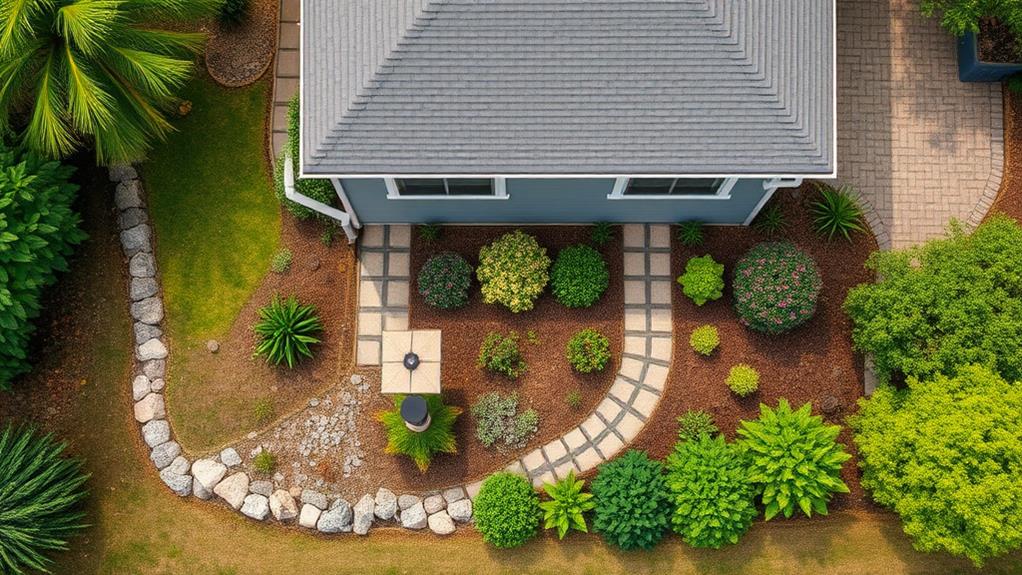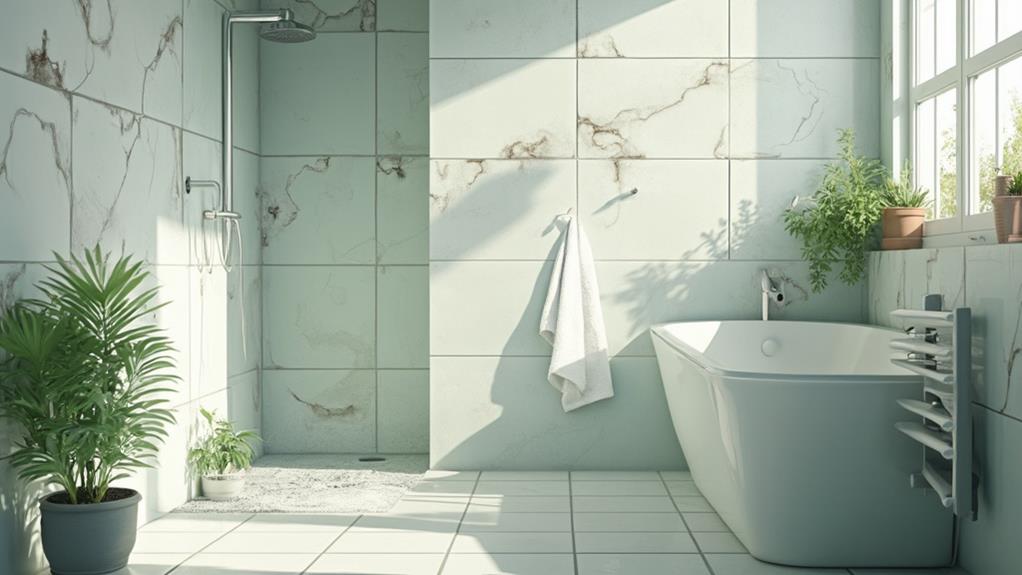Long-term strategies for preventing future mold growth focus on controlling moisture and improving indoor air quality. Key approaches include maintaining relative humidity between 30-50%, enhancing ventilation systems, and using mold-resistant building materials. Regular maintenance and inspections are crucial, along with proper landscaping and drainage to prevent water intrusion. Improving air filtration with high-efficiency filters and promptly addressing water leaks are essential steps. Strategic placement of dehumidifiers in high-humidity areas can further reduce mold risk. By implementing these comprehensive measures, homeowners can create an environment that's inhospitable to mold growth. Explore further to discover how these strategies work together for optimal mold prevention.
Control Humidity Levels

Controlling humidity levels is paramount in preventing future mold growth. Mold thrives in environments with high moisture content, typically above 60% relative humidity. To effectively manage humidity, homeowners should invest in dehumidifiers for areas prone to dampness, such as basements and crawl spaces. These devices extract excess moisture from the air, maintaining optimal humidity levels between 30% and 50%.
Proper ventilation is crucial in controlling humidity. Install exhaust fans in bathrooms and kitchens to remove steam and moisture-laden air. Ensure that clothes dryers vent directly outside, not into attics or crawl spaces.
Regularly inspect and clean gutters and downspouts to prevent water from seeping into the foundation, which can lead to increased indoor humidity. Address any leaks or water damage promptly, as these issues can significantly contribute to elevated humidity levels.
Use moisture-resistant materials in high-humidity areas, such as bathrooms and laundry rooms. Consider applying mold-inhibiting paints or primers to walls and ceilings in these spaces. Lastly, monitor indoor humidity levels regularly using a hygrometer, adjusting your humidity control measures as needed to maintain an environment inhospitable to mold growth.
Improve Ventilation Systems
Building upon the importance of humidity control, proper ventilation plays a key role in preventing mold growth. Effective ventilation systems help remove excess moisture, pollutants, and stale air from indoor spaces, creating an environment less conducive to mold proliferation.
To improve ventilation, start by assessing your current system and identifying areas of poor air circulation. Install exhaust fans in high-moisture areas such as bathrooms, kitchens, and laundry rooms, ensuring they vent directly outside. Consider whole-house ventilation solutions like heat recovery ventilators (HRVs) or energy recovery ventilators (ERVs) to maintain a consistent exchange of fresh air.
Regularly clean and maintain air ducts, filters, and vents to prevent the accumulation of dust and moisture that can foster mold growth. For natural ventilation, open windows and doors when weather permits to encourage air movement. Use ceiling fans or portable fans to improve circulation in stagnant areas.
In basements or crawl spaces, install foundation vents or dehumidifiers to manage moisture levels. By implementing these ventilation improvements, you create an environment that actively resists mold growth, complementing your humidity control efforts and ensuring long-term mold prevention.
Use Mold-Resistant Building Materials

A crucial step in preventing future mold growth involves selecting the right materials for construction and renovation projects. Mold-resistant building materials are designed to inhibit the growth of mold and mildew, providing an additional layer of protection against moisture-related issues.
When choosing materials, opt for mold-resistant drywall, which contains a paperless surface and a water-resistant core. This type of drywall is particularly effective in high-humidity areas such as bathrooms and basements. For flooring, consider mold-resistant options like ceramic tile, sealed concrete, or specially treated hardwood. These materials are less likely to absorb moisture and provide an inhospitable environment for mold spores.
In areas prone to moisture, use mold-resistant paint that contains antimicrobial additives. This type of paint creates a protective barrier on walls and ceilings, reducing the likelihood of mold growth. Additionally, select mold-resistant insulation, such as closed-cell foam or treated fiberglass, which resists moisture absorption and helps maintain a dry environment within walls and attics. By incorporating these mold-resistant building materials into your construction or renovation projects, you can significantly reduce the risk of future mold infestations and create a healthier living environment.
Regular Maintenance and Inspections
To effectively prevent future mold growth, regular maintenance and inspections are essential components of a comprehensive strategy. These proactive measures help identify potential issues before they escalate into serious mold problems.
Conduct routine visual inspections of areas prone to moisture accumulation, such as bathrooms, kitchens, basements, and attics. Look for signs of water damage, discoloration, or musty odors.
Implement a maintenance schedule that includes cleaning gutters, checking roof integrity, and inspecting plumbing systems for leaks. Regularly clean and dry areas with high humidity, such as shower stalls and window sills. Use a dehumidifier in damp spaces to maintain optimal humidity levels between 30-50%.
Schedule professional inspections annually or bi-annually, particularly for hidden areas like air ducts, crawl spaces, and wall cavities. These experts can detect early signs of mold growth and moisture issues that may not be visible to the untrained eye. They can also assess the effectiveness of your current mold prevention measures and recommend improvements if necessary.
Proper Landscaping and Drainage

Proper landscaping and drainage play a crucial role in preventing mold growth by directing water away from your home's foundation. To achieve this, ensure your property has a gentle slope that guides water away from the house. Install gutters and downspouts that extend at least 5 feet from the foundation, preventing water from pooling near the structure.
Consider adding a French drain system to manage excess water in areas prone to flooding or poor drainage. This underground network of perforated pipes redirects water away from problem areas. Additionally, maintain a gap of at least 6 inches between your home's siding and the soil to prevent moisture from seeping into the walls.
Choose plants wisely when landscaping near your home. Avoid water-hungry vegetation close to the foundation, as they can trap moisture. Instead, opt for drought-resistant plants and use gravel or rocks in beds adjacent to the house. Regularly trim trees and shrubs to prevent them from blocking sunlight and air circulation, which can contribute to dampness and mold growth. By implementing these landscaping and drainage strategies, you significantly reduce the risk of moisture-related issues and mold growth in your home.
Enhance Air Filtration
Enhancing your home's air filtration system plays a vital role in preventing mold growth and improving indoor air quality. High-efficiency particulate air (HEPA) filters are particularly effective at capturing mold spores and other airborne particles. These filters can be installed in your HVAC system or used in standalone air purifiers strategically placed throughout your home.
Regular maintenance of your air filtration system is crucial. Replace filters according to manufacturer recommendations, typically every 3-6 months. For optimal performance, consider using filters with a minimum efficiency reporting value (MERV) rating of 11 or higher. These filters can trap smaller particles, including mold spores, more effectively.
In addition to HEPA filters, activated carbon filters can help remove odors associated with mold growth. UV light air purifiers can also be beneficial, as they use ultraviolet radiation to kill mold spores and other microorganisms. For areas prone to high humidity, such as basements or bathrooms, consider installing dehumidifiers with built-in air filtration systems. These devices not only remove excess moisture but also filter the air, creating an environment less conducive to mold growth.
Address Water Leaks Promptly

While air filtration is important for mold prevention, addressing water leaks promptly is equally vital in maintaining a mold-free environment. Water leaks provide the moisture necessary for mold growth, and failing to address them quickly can lead to significant damage and health hazards.
To effectively address water leaks, implement a proactive approach. Conduct regular inspections of plumbing systems, roofs, and foundations to identify potential issues before they become major problems. When a leak is discovered, act swiftly to repair it and thoroughly dry the affected area within 24-48 hours to prevent mold growth.
Install water detection devices in areas prone to leaks, such as basements, bathrooms, and under sinks. These devices can alert you to moisture problems early, allowing for quick intervention. Additionally, maintain proper drainage around your property by ensuring gutters and downspouts are clear and functioning correctly.
Educate occupants about the importance of reporting water-related issues immediately. Establish a clear protocol for reporting and addressing leaks, and ensure that maintenance staff are trained to respond promptly and effectively to water-related emergencies.
Utilize Dehumidifiers Strategically
Strategically placing dehumidifiers in key areas of your home or building can significantly reduce moisture levels and prevent mold growth. These devices work by extracting excess moisture from the air, maintaining optimal humidity levels between 30% and 50%. Focus on areas prone to high humidity, such as basements, crawl spaces, bathrooms, and laundry rooms.
When selecting a dehumidifier, consider the size of the space and its typical humidity levels. Larger units are necessary for bigger areas or those with persistent moisture issues. Ensure proper air circulation around the dehumidifier for maximum effectiveness. Regularly empty the water collection tank or set up a continuous drainage system to maintain consistent performance.
Monitor humidity levels using a hygrometer and adjust dehumidifier settings accordingly. In colder months, you may need to reduce dehumidifier usage to prevent excessive dryness. Combine dehumidification with proper ventilation, especially in bathrooms and kitchens, to further control moisture. Regularly clean and maintain your dehumidifiers, including replacing filters and checking for any signs of wear or malfunction. By utilizing dehumidifiers strategically, you can create an environment that is inhospitable to mold growth and protect your property from potential damage.
Frequently Asked Questions
How Long Does It Take for Mold to Grow After Water Damage?
Mold can begin to grow within 24 to 48 hours after water damage occurs, given suitable conditions. However, visible mold growth may take several days to weeks to become apparent, depending on environmental factors and surface materials.
Can Painting Over Mold Effectively Stop Its Growth and Spread?
Painting over mold is not an effective solution to stop its growth or spread. This approach merely conceals the problem without addressing the underlying issue. Proper mold remediation, including removal and moisture control, is essential for long-term resolution.
Are There Specific Plants That Can Help Reduce Indoor Humidity Levels?
While some may doubt plant effectiveness, certain species can indeed help reduce indoor humidity. Peace lilies, Boston ferns, and spider plants are known for their moisture-absorbing properties. These natural dehumidifiers can complement other humidity control methods in your home.
How Often Should Professional Mold Inspections Be Conducted in Commercial Buildings?
Professional mold inspections in commercial buildings should typically be conducted annually. However, frequency may vary based on factors such as building age, location, previous mold issues, and occupancy. More frequent inspections may be necessary in high-risk environments or after water damage incidents.
What Are the Health Risks Associated With Long-Term Exposure to Mold?
Long-term exposure to mold can lead to respiratory issues, allergic reactions, and skin irritation. Prolonged contact may exacerbate asthma, cause chronic sinusitis, and in rare cases, contribute to more severe health complications like lung infections or neurological symptoms.
Conclusion
The relentless battle against mold demands an arsenal of preventive measures. By implementing these strategies with unwavering dedication, buildings can become impenetrable fortresses against fungal invasion. The synergistic effect of controlling humidity, enhancing ventilation, and utilizing cutting-edge materials creates an environment so inhospitable to mold that spores tremble at the mere thought of proliferation. Vigilant maintenance, coupled with state-of-the-art filtration systems, ensures a future where mold becomes nothing more than a distant memory in the annals of building management.

